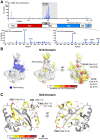This is a preprint.
Architecture and self-assembly of the SARS-CoV-2 nucleocapsid protein
- PMID: 32511359
- PMCID: PMC7263487
- DOI: 10.1101/2020.05.17.100685
Architecture and self-assembly of the SARS-CoV-2 nucleocapsid protein
Update in
-
Architecture and self-assembly of the SARS-CoV-2 nucleocapsid protein.Protein Sci. 2020 Sep;29(9):1890-1901. doi: 10.1002/pro.3909. Epub 2020 Aug 6. Protein Sci. 2020. PMID: 32654247 Free PMC article.
Abstract
The COVID-2019 pandemic is the most severe acute public health threat of the twenty-first century. To properly address this crisis with both robust testing and novel treatments, we require a deep understanding of the life cycle of the causative agent, the SARS-CoV-2 coronavirus. Here, we examine the architecture and self-assembly properties of the SARS-CoV-2 nucleocapsid protein, which packages viral RNA into new virions. We determined a 1.4 Å resolution crystal structure of this protein's N2b domain, revealing a compact, intertwined dimer similar to that of related coronaviruses including SARS-CoV. While the N2b domain forms a dimer in solution, addition of the C-terminal spacer B/N3 domain mediates formation of a homotetramer. Using hydrogen-deuterium exchange mass spectrometry, we find evidence that at least part of this putatively disordered domain is structured, potentially forming an α-helix that self-associates and cooperates with the N2b domain to mediate tetramer formation. Finally, we map the locations of amino acid substitutions in the N protein from over 38,000 SARS-CoV-2 genome sequences. We find that these substitutions are strongly clustered in the protein's N2a linker domain, and that substitutions within the N1b and N2b domains cluster away from their functional RNA binding and dimerization interfaces. Overall, this work reveals the architecture and self-assembly properties of a key protein in the SARS-CoV-2 life cycle, with implications for both drug design and antibody-based testing.
Keywords: COVID-19; Coronavirus; SARS-CoV-2; crystal structure; nucleocapsid.
Figures




References
-
- Zhu N, Zhang D, Wang W, Li X, Yang B, Song J, Zhao X, Huang B, Shi W, Lu R, et al. (2020) A novel coronavirus from patients with pneumonia in China, 2019. N. Engl. J. Med. [Internet] 382:727–733. Available from: http://www.nejm.org/doi/10.1056/NEJMoa2001017 - DOI - PMC - PubMed
-
- Drosten C, Günther S, Preiser W, Van der Werf S, Brodt HR, Becker S, Rabenau H, Panning M, Kolesnikova L, Fouchier RAM, et al. (2003) Identification of a novel coronavirus in patients with severe acute respiratory syndrome. N. Engl. J. Med. [Internet] 348:1967–1976. Available from: http://www.nejm.org/doi/abs/10.1056/NEJMoa030747 - DOI - PubMed
-
- Ksiazek TG, Erdman D, Goldsmith CS, Zaki SR, Peret T, Emery S, Tong S, Urbani C, Comer JA, Lim W, et al. (2003) A novel coronavirus associated with severe acute respiratory syndrome. N. Engl. J. Med. 348:1953–1966. - PubMed
-
- Zaki AM, van Boheemen S, Bestebroer TM, Osterhaus ADME, Fouchier RAM (2012) Isolation of a Novel Coronavirus from a Man with Pneumonia in Saudi Arabia. N. Engl. J. Med. [Internet] 367:1814–1820. Available from: http://www.nejm.org/doi/abs/10.1056/NEJMoa1211721 - DOI - PubMed
